Best Miter Saw Blade – Reviewing 2020’s Top Rated Picks & Buying Guide
- 23 Models Researched
- 36 Hours of Research
- 11 Brands Considered
- 7 Top Picks
Know what to look for
Buy the right blade
Enjoy woodworking again
Searching for the best miter saw blade for your needs can be intimidating and frustrating. We get it. That’s why we did all the hard work for you.
Rather than wasting hours going through dozens of websites and Youtube videos to find just the right blade for you, you can view our handy buyers guide below. We have considered all the important factors to make your choice even easier.
The question we hear most often from readers is: How fine of a cut do you need? A good rule of thumb is the more teeth, the finer the cut.
The problem sometimes comes that with too many teeth, the gullets between them are small and you’ll need to slow your cut speed or you’ll risk the blade binding up causing a rough cut.
The products I’ve chosen are on the higher end for tooth count and should be used for slow, smooth cuts. When used correctly, your results will be ready for use with a minimum of sanding.
In a hurry?
==>> Click for pricing and any available discounts on my nr 1 pick
Contents
5 Best Miter Saw Blades of 2021 – Reviews & Top Picks
Best for Hardwood: Freud D12100X 100T Diablo
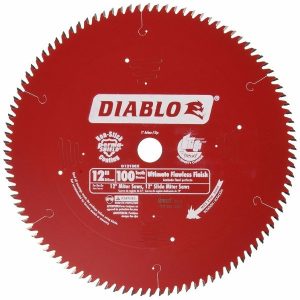
This carbide blade fits most 12 inch mitre saws and after 3 weeks of regular use in my shop still held a very sharp edge. Just be sure you take your time with your cuts and allow the blade to clear the sawdust from the gullets and you’ll be making smooth cuts in no time making it ideal for crown moulding.
In a hurry?
==>> Click for pricing and any available discounts on the Freud D12100X 100
Best for Cutting Trim, Baseboard & 2×4: Hitachi 725206 72-Teeth Tungsten Carbide
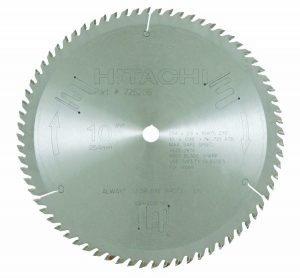
These do tend to dull faster than others I’ve used so I’ve resorted to making everyday cuts with a 40 tooth blade and only pulling out the Hitachi when a fine cut is needed. It performs perfectly in this capacity. If you did want to use this product every day for all the cuts you make I’d imagine you’d need to have it sharpened or replaced within about 4 months of regular use.
In a hurry?
==>> Click for pricing and any available discounts on the Hitachi 725206
Best for Fine Woodworking: Makita A-93681 10-Inch 80T
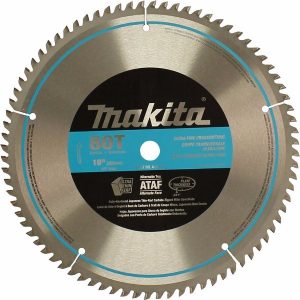
The tooth hook angle on this blade is at 5 degrees. I never really paid much attention to that in the past but found that my mitre saw specifications called for a teeth set between 0 and 2 degrees, which I’m unable to find. Most other blade teeth are set to 7 degrees or close to it. I don’t know that it makes a big difference but the Makita just felt really good on cuts and never deflects.
The pros can’t be wrong, this has to be the nr 1 contender for the best blade for the money.
In a hurry?
==>> Click for pricing and any available discounts on the Makita A-93681
Best for cutting aluminum: Hilti 2014798 SC-C MU 6 ½ inch x ⅝ inch metal blade
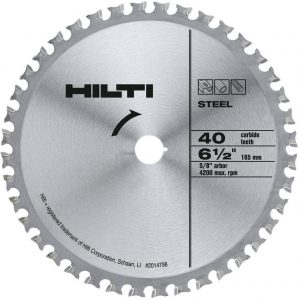
The blade disc is made from robust metal and consists of carbide tips for added durability and accuracy when cutting metal material. The carbide tipped edges limit the heat transfer to the blade and material, which makes for better results.
This is a good choice of a blade for cold cutting, cutting structural panels like pipes, as well as ferrous or oxidized metal.
While this Hilti blade model may be efficient, it comes in at a steeper price than some of its rivals.
In a hurry?
==>> Click for pricing and any available discounts on the Hilti SC-C MU
Best for cutting laminate flooring – Bosch DCB 1040 Daredevil 10 inch 40-tooth general purpose circular saw
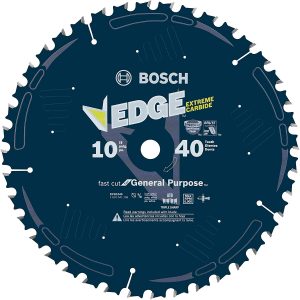
With a thinner kerf, you can trust it to do a clean and technically precise job without the messy fuss of other miter rivals. Because of its multi-function purpose, You can use the Bosch Daredevil blade to cut laminate flooring too.
The robust nature of the miter saw blades reduces the chance of bending for a smooth and accurate cutting experience. The Miter and saw table works together and allows limited vibration, and lower noise levels while in use.
In a hurry?
==>> Click for pricing and any available discounts on the Bosch DCB 1040 Daredevil
Frequently Asked Questions
#1 How do I choose the best miter saw blade?
As a rule of thumb, you have to ask yourself the following questions. In the end it will help you decide on the right applications, the correct tool, and miter saw blades to use.
Consider things like tooth count and materials like table saws or other types of saws that suit the right blade. You’d probably want to ensure you look at the make and quality of the material used in the production of the saws and blades. Manufacturers often hold excellent reputations when it comes to quality.
Lastly, you should source any additional accessories and materials needed for the project before it starts.
What type of materials will you cut?
Before selecting your blade, you have to establish what types of materials need cutting. There’s a blade for most textures including steel and different types of lumber.
Should you have more blades available?
When investing in quality products, the chances of breaking a blade are slimmer. But, if you want to include more blades to your collection, since there are different ones for varied materials, then you can do so. Source saw blades from the best manufacturers for an improved experience.
Will it work with any saw tool?
No. There are some tools that only work with certain blades so it’s important to verify this before you embark on your project. If you are purchasing new, this will make buying the right saw and blades easier. While choosing your saw blades, also check the sizes. Some projects might only require a 10 inch miter, while another could call for a 12 inch blade.
What type of cut do you want the blade to make?
The type of cut comes down to the number of teeth the blade has. Many companies manufacture quality blades and provide a variety of options. You could have a micro grain carbide blade to help create a laser cut, or kerf blades for the correct width. You could also use a specific blade that can cut at an angle.
Is the saw too powerful for the blade?
Again, when selecting the blades to use, check for the best compatibility. The best miter saw will work excellently when it is paired with the correct saw and material to cut.
Some miter saw types include:
- Single-action compound miter saw: has a double bevel to allow for tiling action and maneuvering.
- Standard miter: performs just like the miter box & saw, only this time it is powered by electricity and allows versatility and the ability to implement cornering and crosscuts.
- Sliding-compound miter saw: allow for wider pieces of materials cutting at a wider angle compared to the other saw blades
Less sound
Some miter saw blades have a lower noise emission because of the unique design and placement of the teeth on the disc.Another technique to help reduce sound is the implementation of vibration absorbing fillers and plugs.
Sometimes you can test the “sound-dampening” by tapping the flat part of the blade disc. If it emits a high-pitched “ting” sound, it will be harsher with more vibration. If the sound produced is more of a “low” tone in comparison, then the vibration and sound-reduction is complete through sound dampening.
#2 Are more teeth on the blade better?
Here’s what you need to know about miter saw blades and the teeth:
Besides the durability of the blade disc itself, the teeth play a vital role. A 60 teeth blade, for example, is great for crosscutting, while 100 teeth blades can increase the speed as well as executing a precise cut. People also find using a blade with a count of 100 teeth do an excellent job for cross cutting material grains. Simply put, the tooth count on the blade affects the ability of the blade and the finished design.
Crosscut blades
The higher the tooth count means the smoother and cleaner the cut. The perfect example of crosscut blades is those with 60 or 80 teeth and more.
Rip blades
Rip blades have fewer teeth compared to crosscut blades and these results in a shredding effect when cutting the material. The cons of using rip blades are that it is very “aggressive.” You have to be careful not to use it on materials like melamine, MDF, or plywood because this will shred the edges badly.
It slices quickly through the material but leaves a rougher finish. This may be okay for some people because when working with wood, the rough edges can sand down. But other folks may prefer the smooth textured finish of the higher blade counts.
Rip blades are the best with table saws and they are designed to cut hard materials. They would be harsher and less neat than the 80 teeth and higher miter blades available. You’ll recognise a rip blade miter by its flat teeth that look slightly “hook-shaped.” It also has larger gaps between each other and wide bevals to improve the speed of the blade.
60 Teeth and higher will produce a smoother finish on each side cut. This again showcasing the blades ability to directly effect on the final design. Less miter saw teeth is also cheaper than the smoother precision types.
Blade coatings
Blade coatings are sometimes a preference choice as some manufacturers prefer adding coatings to help cool the saw blade. Some people also believe that with no coating on the saw blade is easier to clean.
#3 Can you sharpen Miter saw blades?
With time, using the same miter saw blade would lead to the blades inevitably becoming blunt. But, that’s not a problem because you can definitely sharpen your saw blade.
The fact that they are resharpenable, makes it a great investment. Being able to regularly maintain the blades from home, add to the versatility and is better for long-term use. A blade of high-quality would last for a long time before needing sharpening provided that it is used correctly and for the correct materials.)
How to sharpen carbide miter saw blades
You can resharpen carbide blades. In some instances, it could cost more or around the same price to sharpen a carbide saw blade as it would be to buy one.
Quality blade brands develop their blades to be robust as well as longer-lasting on sharpness. For peace of mind, you can check out a miter saw blade review from customers before buying one.
When looking at sharpening options, it is a good idea to have it professionally done. If you hand sharpen the blade; it can lead to an uneven finish of the teeth. This would result in a bad cut. But, if you still want to go ahead and hand sharpen in an effort to save on costs then here is a video to show you how it’s done.
There are machines especially designed to sharpen a saw blade and just like having the correct miter saw is important, you also need the right sharpener to tackle this job.
#4 What is the best miter saw on the market?
When it comes to narrowing down the best miter saw on the market, your search starts with brands that you can rely on. But it isn’t just the manufacturer that plays a role in your quest for the leading power miter saw, but also some key characteristics.
A good power miter saw is reliable, versatile, and a must in your power tools collection, even if you’re the DIY enthusiast. A saw fits every cutter’s needs including creating complex 90 degree angle crosscuts. If you need it to tilt for ease of use, then you could go with the single-action compound miter. But tilting to one direction can also have limitations when it comes to reaching further as you work.
In contrast to a tilting type of saw, those that offer more room to move with sliding features may be a better choice for some. Furthermore, the saw needs to have a structure made to endure and a solid “arm” to hold your choice of inch miter blade in place.
Miter saw (basic)
An advantage of having a basic miter saw is that it gives you value for money. It weighs less than other saws and makes working a bit easier. There is no tilt feature to the basic miter saw and this limits reach and the ability to complete bevel cuts.
Compound miter saw
Compound miter saws are great for basic cuts and have some reach thanks to the tilt function. A disadvantage of this one is that it is limited to one direction tilts and cannot do bevel cuts unless the material’s position is shifted upside down.
Double-bevel sliding miter saw
The double bevel miter saw is as its name suggests, and able to cut these edges without changing the material’s position. A disadvantage of having this tool is that it is expensive and the machine needs adjusting to do the job.
Wireless sliding compound
Who doesn’t like being free of cables? But with that comes the cons of battery life. On the up side, cordless means you can move around without the hassle of cable restrictions. But, batteries have limited power and lifespan and thus require charging and monitoring..
Wrapping up the search for the top-rated miter saw blades of 2021
The bottom line with these chop saw blades is they are all well made and will get the job done as long as you use them correctly. If I had to pick just one as the best miter saw blade of 2021, it would be the Makita A-93681 as it is priced a bit below the Freud blade and performs admirably.
This blade from Makita will transform a good saw into a great one.
I’d suggest keeping a number of different blades next to your saw stand if you have the chance. When cutting thick stock like 2×4’s or 4×4’s use a general purpose blade. But, when you need to cut 1 inch stock or thinner, pull out one of these fine cutting blades to make a cut you’d swear was already sanded.
What do you think? Did we miss a favorite of yours? Do you only use fine or ultra-fine blades to make cuts? Let us know your thoughts in the comments below!
